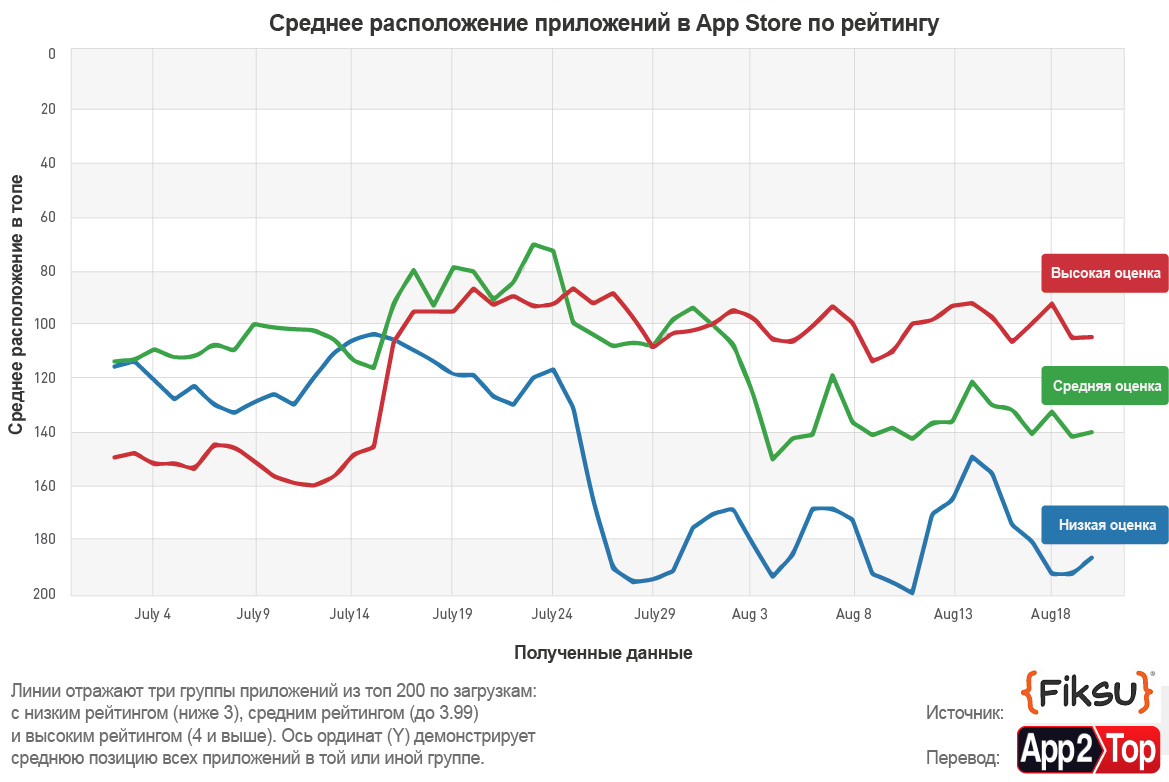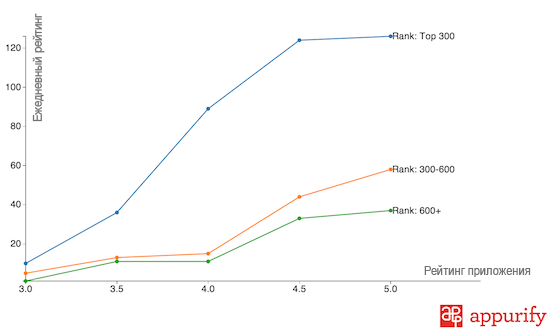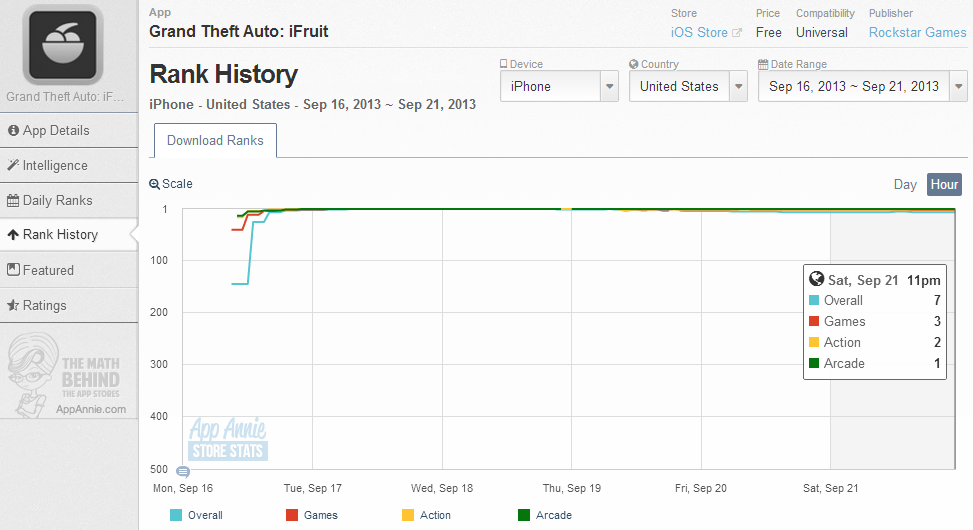About the difficulties of promoting mobile games and the importance of ratings in the App Store in his article on App2Top.ru Galina Divakova, a project manager at the Cliskky company, told us.
The rolling stone gathers no moss. And users don’t run. I mean, the new application will never fire on its own (this, I think, is clear to everyone today).
Of course, there is a slim chance that the new app will get a feature on the main App Store page. But today such a development is possible only in the case of those developers that Apple has already heard about. And, by the way, having an app on the App Store showcase does not negate the need to invest in marketing. After all, as soon as the “finest hour” ends, you will need to retain users, develop success.
In other words, the situation is as follows. If you are working on promoting the app, there is a chance that you will be noticed. And if you’re sitting and waiting for someone to see your brilliant game on the App Store, then this definitely won’t happen.
Preparation
It is necessary to prepare for promotion in parallel with the development. And in several directions at once.
First, monetization. But here we are not talking about the one that is tied directly to the mechanics of the game, but about integration into the SDK application code of advertising networks.
Secondly, user retention. To do this, you need to set up push notifications correctly (the frequency of their appearance, phrases, and so on), come up with various promotions (a la, visit the game every day, get buns, and so on).
Thirdly, analytics (and its settings, since the fact that you have integrated the SDK of a popular service into the game will not give anything in itself).
And I’m not talking about the need to work with social networks, linking to which will not only give access to data about players (age, gender, geography), which will automatically serve as an excellent source of information for further advertising campaigns and, potentially, increase virality.
In my experience, one month is generally enough to prepare marketing activities directly for the release. The main task is to make sure that everything you cook shoots in one day – websites and blogs, social media have written about the application, mailings have been sent.
Optimization
It is always possible to strengthen positions in the store by optimizing the description (App store optimization or ASO) and PPC/PPI campaigns. Actually, I would like to tell you about this in more detail.
Over the past couple of years, ASO has been turned into a whole science. There are subtleties both on the App Store and on Google Play, but for both stores, a beautiful icon and a good descriptive name are important (for example, if you are making an application with answers to problems, you should call it not “Answer Book”, but “Answer Book: solving problems in physics, mathematics, chemistry, grade 9”).
Screenshots play an important role, or rather, promo posters demonstrating the full functionality of the application. For Google Play, you should also prepare a video.
By the way, the latter is more tied to SEO, so if we write a short catchy text in the App Store, then in Google Play, putting it at the beginning, you can still safely add a paragraph with all the keywords, and even include a keyword in the name of the application itself.
But maybe that’s not the case now.
Evaluations
Fiksu Agency in August published news about changes in the algorithm for building app ratings in the App Store. In their opinion, the height in the charts is now affected not only by the number of downloads over a certain period of time, but also by user ratings.
Previously, ratings (in the free top) were governed by the number of races and the period for which they occur. But at the end of this July, Fiksu noticed that the ratings of several applications fell without changes in the amount of traffic they received. They linked the position changes to the ratings of these applications. Applications with a high rating (4.5 stars) retained their positions, applications with three stars and below, as you can see in the diagram, fell noticeably.
Moreover, the rating began to be updated not every 15 minutes, but every three hours – probably so that Apple could stop the ratings cheating on time.
The whole situation, of course, raised a fuss on the Internet. We decided to look for ourselves at how the applications promoted in Clickky behaved on approximately the same dates that Fiksu wrote about.
The first application has an average score of 4.5 stars. The second one has about 3.5.
When the same amount of traffic was injected at a certain time, the position of the first application in the overall standings fluctuated, but not by more than 70 positions. At the same time, in the Productivity category, it kept its result, even when the campaign was suspended, due to the fact that users noticed it in the top and continued to download it.
At the same time, the application with a rating of 3.5 first grew, but then began to lose ground, and additional traffic was needed for the application to return to its original place. The loss was about 60 positions. Perhaps it was really connected with Apple’s innovations.
An additional criterion for the importance of assessments
Another company, Appurify, has also published a study on the importance of user ratings. But they came from the other side, as it turned out – no less significant. The table shows that applications with good scores receive more new ratings than applications with ones and twos. This is especially clearly seen at the border of 4 and 4.5 stars – there the number of ratings increases threefold. It turns out that a large number of good points encourages other users to also share their impressions about the application.
The same Appurify drew attention to the influence of the place of applications in the top on the activity of evaluation by users. For example, two applications from the top 900, with ratings of 3.5 and 4.5 stars, rose equally to the top 300. An app with a rating of 4.5 received much more user comments than an app with 3.5.
In other words, in theory, the higher you get to the top, the more important your app’s ratings are.
What is it now?
In September, we returned to this issue and conducted a little more research.
The free Pimp My Keyboard application, which clearly received additional traffic, turned out to be on the 1st place in the American rating with a rating of 1.5 stars. Despite the negative reviews, it remained at the top for a week.
Another application released by Rockstart Games, during the release of GTA 5 on September 16, collected positive reviews. However, the next day there were problems in the application. This caused a wave of negative comments – as many as 7000 units. Despite this, GTA hung as high in the category of games as before, and in the overall standings lost only five positions for all time.
A week later, the app was ranked sixth in the free iPhone US chart. A huge number of low ratings did not pull him down.
So, it’s too early to shout that Apple has stuck sticks in the wheels of developers, but it’s definitely worth thinking about how to make the reputation of your application positive. Especially then, if you are going to bring the application to the top. Since Apple is already at least testing a new issue of app ratings, perhaps the moment is not far off when ratings will begin to matter.
How to work on the reputation of the application?
I think there’s nothing new here:
- fix bugs and warn users about them;
- ask users to rate the application;
- remind users about the installed application using notifications (as Angry Birds often do) or newsletters (as Evernote sometimes does);
- and when buying traffic to get into the top, do not forget that good ratings will bring three times more new users.
- And the most important thing is to make a quality product that people will want to download.
The material was written based on the speech of Galina Divakova, project manager at Clikky, at the Social Rocks with the report “Mobile app promotion: downloads or reputation?”
Clickky is a mobile advertising platform with payment for the installation of iOS & Android applications. Recently, the company launched its own in-house agency MadApp for comprehensive application promotion.







